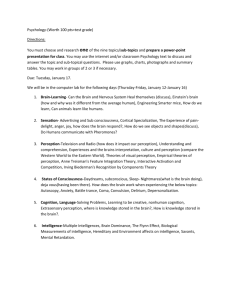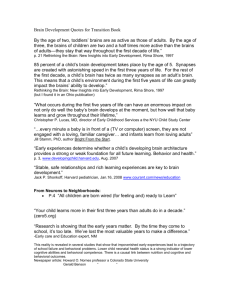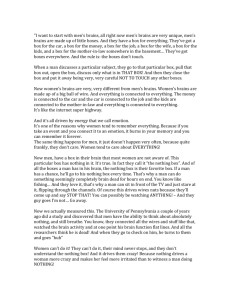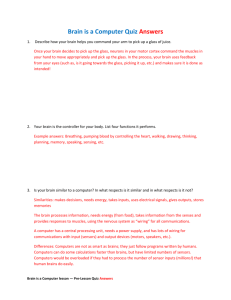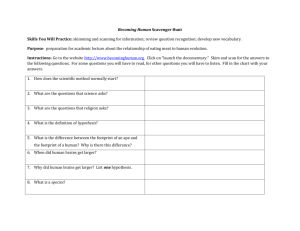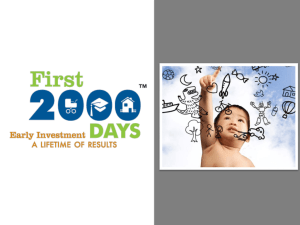resources
advertisement
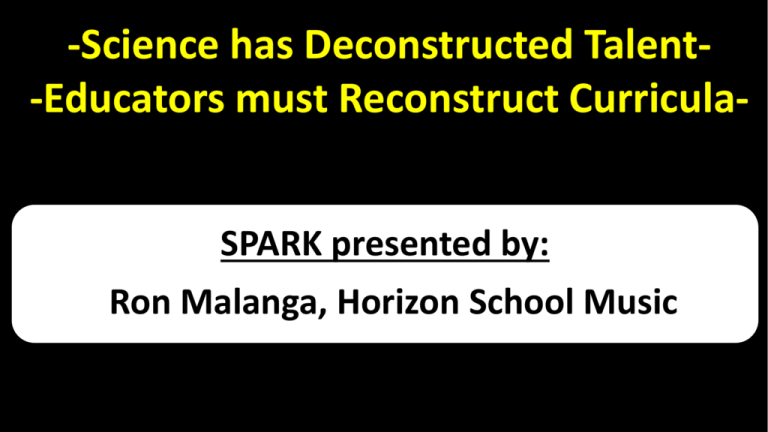
-Science has Deconstructed Talent-Educators must Reconstruct CurriculaSPARK presented by: Ron Malanga, Horizon School Music In early childhood, we ready kids to think in the 8 tone languages and kinesthetically move/feel the 4 rhythm languages of music. Because attention is limited, words get in the way of these crucial acculturation processes (No music learning is possible without them!). Strive for 30 minutes a day of music-only interactions. If you must use words, sing what you wish to say! Remember, the products of music & language learning are delayed. We speak for almost a year to a child, expecting no verbal responses. We must do the same for the tone & rhythm languages of music. A variety of wordless songs & flowing movements from parents & caregivers provide the ideal music acculturation for the very young. Language & Music: Identical Purposes & Learning Windows Language • Results from a need to communicate. • Thought is what gets communicated. • Sound is how we communicate. • Ideal learning window: birth to age 3. Music Results from a need to communicate. Thought is what gets communicated. Sound is how we communicate. Ideal learning window: birth to age 3. Because of your early childhood experiences, today you command language in all it’s forms (regardless of talent). Give kids these early childhood experiences with music content and they will command music in all it’s forms (regardless of talent). Language & Music: shared processes; different contents. Language Learning from Birth Ideal Music Learning from Birth • Listen—experts speak directly to you • • • • • • • • Listen—experts sing & rap directly to you Acculturate—absorb expert sounds Acculturate—absorb expert sounds Babble—your explorations are encouraged Babble—your explorations are encouraged Think/Comprehend—point, follow instr, etc. Think/Comprehend—find keynote, beats, etc. Perform—self-taught speech (initially single words) Perform—self-taught singing (initially single patterns) Construct—improvise sentences & converse Construct—improvise pattern series & converse Expand/Refine Vocabulary—words Expand/Refine Vocabulary—tone & rhythm patterns Read/Write—icon assoc., recall & drawing Read/Write—icon assoc., recall & drawing Text & Type—make muscles mirror thought Play—make muscles mirror thought (‘tone text’) Because of your early childhood experiences, today you command language in all it’s forms (regardless of talent). Give kids these early childhood experiences with music content and they will command music in all it’s forms (regardless of talent). In early childhood we hear sentences (wholes) we don’t fully grasp, as we learn parts (words) we improve our understanding of the wholes. It’s the same for music!! -Experience- Whole Hear rich sentences. Hear rich melodies. -Analyse- -Synthesise- Part Whole Learn more words. Improved comprehension. Learn more patterns. Improved comprehension. The easy way? Move with flow and: Listen Converse Learn More? Google: mindmusclemusicmyth Early Childhood Essentials: http://mindmusclemusicmyth.blogspot.ae/2009/10/earlychildhood-music-presentation.html How Rhythm is Learned: http://mindmusclemusicmyth.blogspot.ae/2010/11/how-rhythmreally-works.html How Tone is Learned: http://mindmusclemusicmyth.blogspot.ae/2009/10/effective-tonaldevelopment.html Ron Malanga, Horizon School Music www.mindmusclemusicmyth.blogspot.com THE FOLLOWING SLIDES WILL NOT BE USED IN THE PRESENTATION. I will merely mention that should the participants want a more in-depth look, the slide show also contains more information. What Brains Need vs. What Kids Get Ron Malanga, Horizon School Music [Supplementary material for SPARK 11 Nov. 2015, Cambride Int’l School, Abu Dhabi] It's not for lack of talent that most adults aren't particularly musical, but rather that they lived unhelpful curricula. My goal is to highlight the curriculum gaps in music education that cause achievement gaps in music skills (which we later excuse by claiming lack of talent). If even a 1/3 of the research points below are correct, then every one of us and every one of our students could be that much more musical! • Brains need: Child-friendly ranges modelled by mom. • Children get: Adult-friendly ranges heard in recordings. • Brains need: Improvisational play. • Children get: Imitative work. • Brains need: Large-muscle flowing movements. • Children get: Small-muscle angular movements. (clap/xylo). • Brains need: To alter music to discover its deeper structures. • Children get: To preserve music to deliver surface structures. • Brains need: Musically rich melodies, devoid of lyrics. • Children get: Lyrically rich songs, devoid of melody. • Brains need: Models of free-flowing movement. • Children get: Models of rigidly choreographed dance. • Brains need: Movement while listening. • Children get: Sitting still while singing. • Brains need: Whole – Part – Whole educating. • Children get: Whole – Whole – Whole inculcating. • Brains need: Family members singing directly to them. • Children get: Recordings rapping indirectly near them. • Brains need: Sequential skill-building. • Children get: Non-sequential concert rehearsing. • Brains need: To hear melodies, & extract music content. • Children get: To sing songs, & extract linguistic content. • Brains need: Separate tone & rhythm study. • Children get: Combined tone & rhythm memorization. • Brains need: 20 – 40 seconds of rich melodic listening. • Children get: 2 - 3 minutes of impoverished singing. • Brains need: Conversational; ‘Question & Answer' singing. • Children get: Simultaneous ‘Answer only' singing. • Brains need: To construct music; pattern by pattern. • Children get: To copy songs word by word. • Brains need: To learn to read notation as 'icons that sing.' • Children get: To learn to decode notes as ‘muscle instructions.' • Brains need: To be constructing music. • Children get: Constricting literature (Save it for later!). • Brains need: Individual differentiation of musical content. • Children get: Group standardization of musical content. • What brains need: Deep structure variety (all modes & meters). • What children get: Deep structure sameness (major & duple). • Brains need: Ear-to-hand performance. (Embodied sound) • Children get: Eye-to-hand performance (Embedded movement). • Brains need: A variety of modes with consistent keys. • Children get: A variety of keys with consistent modes. • Brains need: Vertical comprehension of harmonic structures. • Children get: Horizontal memorization of melodic structures. • Brains need: A variety of meters, consistency of tempo. • Children get: A variety of tempos, consistency of meter. • Brains need: To learn writing as 'singing icons onto a page.' • Children get: To learn writing as silent, theory-laden calligraphy. • Brains need: Flow, Weight, Tempo, Meter, Rhythm Patterns. • Children get: Rhythm Patterns (devoid of meanings imparted by Flow, Weight, Tempo, & Meter) . • Brains need: Syntax then Sounds then Syllables then Synthesis then Symbols. • Children get: Symbols (devoid of meanings imparted by Syntax, Sound, Syllables and Synthesis). • Brains need: 1-Assimilate modes, 2-Derive tonal centers, 3Accumulate patterns. • Children get: 1-Scales, 2-scales, 3-more scales.


